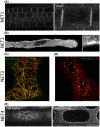Membrane contact sites and cytoskeleton-membrane interactions in autophagy
- PMID: 35648104
- PMCID: PMC9545284
- DOI: 10.1002/1873-3468.14414
Membrane contact sites and cytoskeleton-membrane interactions in autophagy
Abstract
In Eukaryotes, organelle interactions occur at specialised contact sites between organelle membranes. Contact sites are regulated by specialised tethering proteins, which bring organelle membranes into close proximity, and facilitate functional crosstalk between compartments. While contact site proteins are well characterised in mammals and yeast, the regulators of plant contact site formation are only now beginning to emerge. Having unique subcellular structures, plants must also utilise unique mechanisms of organelle interaction to regulate plant-specific functions. The recently characterised NETWORKED proteins are the first dedicated family of plant-specific contact site proteins. Research into the NET proteins and their interacting partners continues to uncover plant-specific mechanisms of organelle interaction and the importance of these organelle contacts to plant life. Moreover, it is becoming increasingly apparent that organelle interactions are fundamental to autophagy in plants. Here, we will present recent developments in our understanding of the mechanisms of plant organelle interactions, their functions, and emerging roles in autophagy.
Keywords: actin; autophagy; chloroplast; contact site; cytoskeleton; endoplasmic reticulum; membrane; mitochondria; plasma membrane; vacuole.
© 2022 The Authors. FEBS Letters published by John Wiley & Sons Ltd on behalf of Federation of European Biochemical Societies.
Figures



Similar articles
-
Plant NETWORKED and VAP27 Proteins Work in Complexes to Regulate Membrane-Based Functions.Contact (Thousand Oaks). 2025 May 27;8:25152564251342533. doi: 10.1177/25152564251342533. eCollection 2025 Jan-Dec. Contact (Thousand Oaks). 2025. PMID: 40458073 Free PMC article. Review.
-
Organelle contact zones as sites for lipid transfer.J Biochem. 2019 Feb 1;165(2):115-123. doi: 10.1093/jb/mvy088. J Biochem. 2019. PMID: 30371789 Review.
-
Keep in contact: multiple roles of endoplasmic reticulum-membrane contact sites and the organelle interaction network in plants.New Phytol. 2023 Apr;238(2):482-499. doi: 10.1111/nph.18745. Epub 2023 Feb 9. New Phytol. 2023. PMID: 36651025 Review.
-
Proximity-Ligation Assay to Detect Peroxisome-Organelle Interaction.Methods Mol Biol. 2023;2643:135-148. doi: 10.1007/978-1-0716-3048-8_10. Methods Mol Biol. 2023. PMID: 36952183
-
Different tether proteins of the same membrane contact site affect the localization and mobility of each other.J Cell Sci. 2023 Jul 1;136(13):jcs260786. doi: 10.1242/jcs.260786. Epub 2023 Jul 4. J Cell Sci. 2023. PMID: 37303255
Cited by
-
ER-associated VAP27-1 and VAP27-3 proteins functionally link the lipid-binding ORP2A at the ER-chloroplast contact sites.Nat Commun. 2024 Jul 17;15(1):6008. doi: 10.1038/s41467-024-50425-7. Nat Commun. 2024. PMID: 39019917 Free PMC article.
-
Plant NETWORKED and VAP27 Proteins Work in Complexes to Regulate Membrane-Based Functions.Contact (Thousand Oaks). 2025 May 27;8:25152564251342533. doi: 10.1177/25152564251342533. eCollection 2025 Jan-Dec. Contact (Thousand Oaks). 2025. PMID: 40458073 Free PMC article. Review.
-
The interactions of subcellular organelles in pulmonary fibrosis induced by carbon black nanoparticles: a comprehensive review.Arch Toxicol. 2024 Jun;98(6):1629-1643. doi: 10.1007/s00204-024-03719-0. Epub 2024 Mar 27. Arch Toxicol. 2024. PMID: 38536500 Review.
-
Targeting membrane contact sites to mediate lipid dynamics: innovative cancer therapies.Cell Commun Signal. 2025 Feb 15;23(1):89. doi: 10.1186/s12964-025-02089-z. Cell Commun Signal. 2025. PMID: 39955542 Free PMC article. Review.
-
Better Together: Interorganellar Communication in the Regulation of Proteostasis.Contact (Thousand Oaks). 2024 Oct 8;7:25152564241272245. doi: 10.1177/25152564241272245. eCollection 2024 Jan-Dec. Contact (Thousand Oaks). 2024. PMID: 39385949 Free PMC article. Review.
References
Publication types
MeSH terms
Grants and funding
LinkOut - more resources
Full Text Sources

